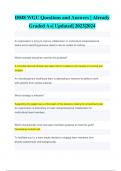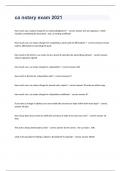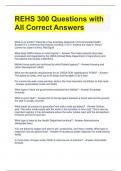Animal Disease Weeks 1-13
, • Haemoc
Immune System Components •
•
•
Lymphoi
Natural K
Lymphoc
• B-Cell
• T-Cell
• Plasma C
• Myeloid
• Megakar
• Thrombo
• Erythroc
• Mast Ce
• Myelobl
• Basophil
• Neutrop
• Eosinoph
• Monocy
• Macroph
, Immune Cells
Macrophage
Immune Cells
All immune cells come from
Pluripotent Haematopoietic
Neutrophil
Stem Cells & give rise to B
Cells, T Cells & NK Cells.
Eosinophil
Mast Cell
Basophils
Lymphocytes
(T-Cells)
Lymphocytes
(B-Cells)
Natural Common Myeloid Progenitor Cells =
Killer produce granulocyte/macrophage pro
Cells
which give rise to eosinophils, basoph
Monocytes
,The Immune System
A complex network of cells & soluble molecules which interact with one
Immune System Error
Autoimmunity = failure of immune system to distinguish self from non-self.
Allergy = inappropriate response to an environmental antigen.
Immunopathology = tissue damage due to extreme immune response.
Mononucleated L
Monocytes & Ma
Polymorphonucle
another to remove foreign material from the body. Neutrophils, Baso
Importance:
• Inflammation Immunotherap
• Immunity Vaccination & Immunological Memory T-Cells = can de
• Disease Primary Response = first encounter with a pathogen, body • Use antibodi
• Vaccines makes antibodies. • Causes the re
• Immunotherapy Secondary Response = 2nd exposure to pathogen, antibodies
already present & so rapid, non-symptomatic encounter.
Innate Immune System:
• Non-Specific Recognition Lymphocyte
• No memory (2nd encounter causes same response) Recirculation
• Barrier to infection (HEV)
• Recognises cellular components
• Contains soluble factors
[Phagocytes, Neutrophils, Macrophages et.] Lymphocyte
Homing
Innate: can eradicate an infection or at least slow it until adaptive response occurs.
Location = found on skin, respiratory tract & Alimentary tract (Prevents colonisation).
Dendric Cells: activate adaptive immune response.
Soluble Innate Factors
Complement: coats pathogens in molecules that innate cells
have receptors for causing opsonisation.
Acute phase: activates complement system.
Interferons: activates cells to produce anti-viral proteins.
Tissue Macrophages = mediate cellular defence
Feline Immune Disease (FIV) Specialised Recirculation: Interaction between vascular Neutrophils = mediate the major defence against
Caused by a decline in CD4 T-Cells. common mucosal cells addressin & homing receptors in Eosinophils = defence against helminths.
activate in response to an HEVs (Turbulence & Diapedesis). Natural Killer Cells = defence against viral infecti
Symptoms: poor coat condition, fever, event, that can go home to
diarrhoea, no appetite & gum inflammation. another mucosal surface. Complement Systems =humoral defence of tissu
,Immune System Tissues Bone Marrow
•
•
B-Cells Mature here (Humans, rabbits & rodents)
Pluripotent stem cells
Secondary Unencapsulate
• Found at mucosal Surfa
external environment.
Primary Immune System = where immune system develops. • B-Cell differentiation into plasma cells
• Ileal Peyers Patch • Origin of T & B Cells MALT: mucosa-associated
• Thymus Bursa Of Fabricius • Gastrointestinal, Nasal, B
• Bone Marrow • Only in Birds Thymus • BALT (Bronchial) & NALT
• Bursa of Fabricius (Birds) • Lymphoepithelial • Located near heart (Anterior Mediastinum)
organ • Extramedullary T-Cell development Peyers Patches: found alon
Secondary Immune System = sites of immune responses. • B-Cell maturation • T-Cells needed for mediated immunity • Patches contain T & B Ce
• Spleen (Encapsulated) • Near cloaca • Involutes with age • They sample intestine co
• Lymph Nodes (Encapsulated) immune response if need
• Mucosal Lymphoid Aggregates (Un-encapsulated) Ileal Peyers Patches T-Cell & B-Cell Recept
• B-Cell maturation
• Located in small intestine
between Villi Domed T-Cell
Area & B-Cell follicles.
Lymphocyte:
The Spleen • Memory Cells
• Few organelles/cytoplasm
• Condensed Chromatin
The Spleen
• Can be T-Cell or B-Cell
• Encapsulated • Inactive (Naïve/ memory) Lymphoblasts:
• T or B Cells
Red Pulp = red blood cells Plasma Cell • Stimulated by antigens
Marginal Zone: contains White Pulp = B & T Cells • Contains endoplasmic reticulum • More organelles & cytoplasm
dendritic cells & macrophages. • Late stage B-Cells • Less condensed chromatin
PALS: Peri-Ateriolar Lymphoid Sheath • Produce & Secrete antibodies
• Found in white pulp
• Contain T-Cells Identifying B Cells (Immunofluore
T or B Cell? 1) Take sample of T/B Cells
Mucosa- Associated Lymphoid • Location? 2) Add antibodies specific to cell surfa
Cell Follicles: • Function? 3) Antibody is attached to fluorochrom
Tissues = Gastrointestinal, • White pulp • Expressing which 4) Antibody binds to SmIG receptors o
bronchial & nasal conjunctiva. • Contain B-Cells surface molecules? 5) B-Cell then exposed under UV light
, Immune System Tissues (Secondary)
Humoralism: disease resulting
Lymph Node from imbalance of four
humours (Blood, Yellow Bile,
Black Bile & Phlegm).
Lymphocyte Recirculation
Maximises the chance of contact be
and the appropriate responding pop
lymphocytes.
HEV = High Endothelial
Venules. (Lymphocytes
move into tissue or
lymph nodes).
Primary Follicles = Immature B-Cells
Secondary Follicles = Mantle Zone & Germinal Zone. (Activated B-Cells) Two Main Areas:
Medullary Area
[Follicles found within cortex area] Cortex Area
• Cortex = B-Cells
• Paracortex = T-Cells
, Taxonomic Groups
Infectious Agents Overview Viruses
Bacteria
Fungi
Pathogen = anything that can produce disease. (Virus, Bacteria et.) Protozoa
Infection = invasion of hosts bodily tissue by a disease causing agent. Helminths
Transmission = passing of a communicable disease from an infected host individual/ group to another individual/group. Arthropods
Zoonosis = infectious disease that is transmitted between humans & animals. Prions
Microorganisms = microscopic organism. Single or multi celled. Cancerous Tissue
Pathogenicity = potential capacity of a particular species of microorganism to cause disease.
Virulence = the degree of pathogenicity within a agent of infectious disease. Indicated by host fatalities or ease of invasion
Vector = living organism that carries & transmits an infectious agent into another living organism. Borrelia Burgdorf
• Lyme Disease
Pathogenic Bacteria • Spirochaetes sha
Viruses • Transmitted via
• Require host to survive Species = some species can be both
• Hijack host cells mechanisms pathogenic & non-pathogenic.
Bacteria
• Kills host cell via lysis • Single Celled Organisms Mycobacterium Bovis
Secondary Infection: bacteria often infect
Genetic Material = in capsid/lipid envelope. (DNA/RNA) • Prokaryotic (No Nucleus) • Bovine TB
after a viral infection has occurred in host.
• Multiply via binary fission • Intracellular bacteria
Foot & Mouth Disease • Zoonosis
• Highly contagious Shapes: • Incubation period
• Affects upper alimentary system & feet Beneficial Bacteria
Cocci (Spherical) • Intestinal bacteria (Digestion)
• Small RNA Virus Bacilli (Rods & cylinder)
• Very resistant in environment • Recycle nutrients Bacil
Spirochaetes (Spirals) • Clear dead material • An
• Fix nitrogen & Clean water • Gr
Classical Swine Fever
• Industrial uses (Fermentation) • Ra
• Disease of wild boar & pigs
• Food preservation • Sp
• Caused by Pestivirus (RNA Virus)
Influenza Virus • Fa
• High mortality
• Asymptomatic carriers common • Originated in wildfowl
• RNA Virus Brucella Bacteria Clostridium Botu
Rabies Virus • Crosses species barrier •
• Gram Negative Rods Gram Positive R
• Causes acute encephalitis • Constantly evolving E.Coli •
• Causes abortion & arthritis Anaerobically gr
• Caused by Genus Lyssavirus (RNA) • Gram Negative Rods • Transmitted via birth • Produces toxins
• Transmitted via bites Corona Virus • Intestinal disease materials • Paralysis
• Long incubation period • Natural hosts are Bats • Young animals • Zoonotic • Found in badly c
• Reservoirs in wildlife • Originated in poultry • Zoonotic • Found in wildlife
,Infectious Agents Overview Protozoa (Parasite)
• Single Celled
• Eukaryotic
• Multiply via binary fission or Asexual
Plasmodium (Pr
•
•
•
Malaria
Fever/Anaem
Vector paras
Fungi Prions • Anopheles M
Mostly non-pathogenic Misfolded proteins that can cause normal protein to misfold. • Cerebral Sym
[Yeasts & Molds] • Abnormal brain protein
• Causes brain disease
Pathogenic Fungi • Very fatal
• Resistant to disinfection
Coccidia (Protozoa) Trypanosoma (
Ringworm = dermal infection. • Domestic Species
Aspergillosis = Internal infection. • Sleeping sic
E.g. Mad Cow Disease & Scrapie • Gastrointestinal issues • Death
Ergotism = mycotoxins • Reproductive losses
White nose disease = Bats • Anaemia
Transmissible Cancerous Tissue = transferred via direct contact. • Direct & Indirect Life cycles • Extracellula
Chytridomycosis = Amphibians • Intermediate hosts
• Canine Transmissible Venereal Tumour (Sexual Contact) • Tsetse Fly (V
• Facial Tumour Tasmanian Devils (Fighting) • Sexual Reproduction
Infectious Transmission
Helminths (Classification) Source of Transmission: Vertical Transmission: Inhalation (TB, Liver Fluke)
• Complex lifecycles • Another diseased animal infection passes from one • Enter lungs, can spread to o
Mushrooms: edible, generation to the next.
• Many hosts/species • A healthy carrier animal
therapeutic, poisonous • Cross placenta Ingestion (Foot & Mouth, Live
• Animal reservoir
& hallucinogenic. • Bovine Viral Diarrhoea • Effects Intestinal tract or or
1) Nematodes (Roundworms) • The Environment • Toxocara Canis
• Gastrointestinal Tract
• Lungs, Heart & Liver Inoculation (West Nile Virus o
• Majority harmless Disease Severity (Depends Upon) • Pathogen is injected into ho
• Economic loss for farms Arthropods • Virulence of pathogen vectors
• Resistance to the host of colonisation • Systemic Disease
Insects (6 Legs)
2) Cestodes (Tapeworms) • Biting flies • (Acquired or innate resistance? The Triad
Sexual contact (Venereal Tum
• Zoonosis issues • Blow flies • Food availability
• Intermediate hosts • Nuisance flies • Stress factors
Deposition (Blow Fly Larvae)
• Public health threat
• Pathogen is deposited on th
Acari (8 Legs) Macroparasites = helminths & arthropods. spreads and penetrates.
3) Trematodes (Flatworms/Flukes) • Ticks • Mites & Ringworm
• Snails act as hosts • Mites
• Economic loss for farms Fly Strike = larvae penetrate
• Zoonotic Vectors = Mosquitos & Midges
skin causing lesions.
Pathogens = Fleas & Horsefly
, Cellular Injury Stimuli
Cellular Injury, Responses & Adaptions Cellular Adaption
Internal:
• Oxygen deprivation
• Nutritional Imbalance
• Ageing
What Pathological Stimuli Causes Stress: caused by pathological If the limit for cellular adaption is exceeded, cellular • Genetic Abnormalities
Adaptive Cellular Changes? stimuli, can cause cellular adaptions injury will result. • Workload Balance
• Increased workload resulting in altered steady state.
• Decreased workload Stress Removed: adaptions can Cellular Injury is reversible up until a certain point. External:
• Chemical Injury reverse. • Depends upon severity of stimuli • Infectious Agents
• Physical Injury • Physical Agents
Pathological Calcification of Tissues • Chemicals/Toxins
Occurs when stimuli is severe & persistent. Cell Death: occurs if injury is irreversible.
Cell Structure
, Cellular Injury, Responses & Adaptions Ectopia: tissue grows in t
Hypertrophy
Increase in the size of cell due to increase in number or size of the organelles.
• Leads to organ Hypertrophy
• Both hypertrophy & hyperplasia can occur simultaneously
Hyperplasia Atrophy = reduction in mass of organ/tissue tha
Persistent hyperplasia may normal due to reduction in number or size of cel
increase the risk of neoplasia. Hypoplasia = decrease in number of cells, de
Only occurs if cell population (Congenital Anomaly)
is capable of division. Hyperplasia = increase in the number of cells w
Adrenal Cortex Metaplasia = change from normal cell type to other cell type tha
the stress. (Could impact tissue function, if cell type isn’t suitable f
Hypertrophy = this
occurs when there is
Dysplasia = reversible/ partially reversible change characterised
an increase in
(Pre-Neoplastic).
circulating ACTH, • Epithelial tissues (Most Common)
increasing functional • Often due to chronic inflammation
demand of the
adrenal cortical cells Adrenal cortex
to produce more Adrenal Cortex Atrophy administration
cortisol. (Excessive nega
decreases ACTH
Causes of Hypertrophy & Hyperplasia
• Increased workloads (Demand) Cell Atrophy
• Reactive responses to inflammation The size/mass of the cell decreases.
• Increased hormonal stimulation • Diminished function
• Age related proliferation (E.g. • Causes organ atrophy
Nodular Hyperplasia of Liver)
Causes:
• Decreased workload (Disuse Atrophy)
• Loss of cells without replacement Decreased
E.g. Prostatic Hypertrophy in Dogs • Deprivation of nutrients/growth factors.
• Older dogs Cortisol
• Loss of innervation or blood supply
• Enlarged prostate • Reduce hormone stimulation
production
• Increase in number & size of cells Cortisol







